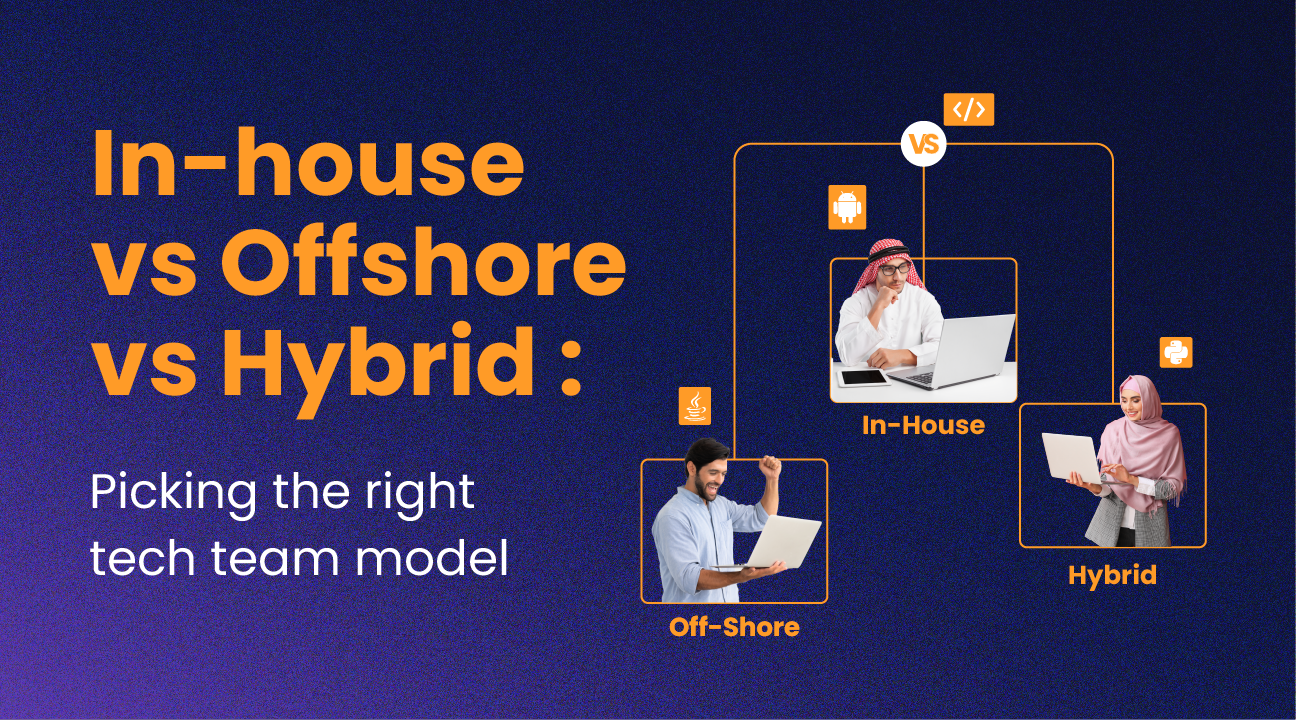Contents
- 1 Introduction
- 2 What is custom software development?
- 3 Custom software vs off-the-shelf software
- 4 Benefits of custom software development for Middle East businesses
- 5 Businesses in Dubai & Saudi Arabia embracing custom software solutions
- 6 Applications of custom software solutions: 6 key industries in the middle east
- 7 Scaling Your Software for Future Growth
- 8 Tech stack behind a custom software solution
- 9 How to approach a custom software development project
- 10 Cost of custom software development
- 11 Common misconceptions about custom software
- 12 How can Competenza help in building your custom software solution
- 13 Conclusion
- 14 FAQs
Introduction
In the Middle East, businesses today face challenges that generic, off-the-shelf software can’t fully address—especially when it comes to region-specific regulations, multilingual operations, and complex internal workflows.
That’s where custom software development comes in. Built specifically to meet a company’s unique requirements, custom solutions offer greater flexibility, better integration with existing systems, and long-term scalability.
For businesses in markets like the UAE, Saudi Arabia, and Qatar, this often means stronger compliance, localized features, and the ability to support growth without being limited by rigid software frameworks.
In this guide, we’ll explore what custom software development really involves, how it compares to standard software options, and what Middle East companies should consider before taking the plunge- from cost and planning to the technology stack and long-term ROI.
What is custom software development?
Custom software development means building software that’s made to fit your business and not the other way around.
Instead of adjusting your workflows to a generic tool, a custom-built software is designed around how your business already operates or how you want it to operate as you scale.
Every feature, integration, and user experience is built intentionally to support your processes, regulatory needs, and growth plans.
In practice, this could mean:
A fleet management dashboard for a UAE-based logistics company, integrating real-time GPS tracking, automated customs clearance updates, and Arabic/English operator interfaces.
Custom software isn’t about adding features to a standard tool. It’s all about crafting a system that fits how your company operates, giving you better connectivity, tighter rule-following, and more hands-on control over your operations.
Custom software vs off-the-shelf software
When choosing a software solution, businesses need to compare building a custom software solution that fits their exact need with purchasing an off-the-shelf product that’s ready to deploy.
Both approaches have trade-offs. But for companies operating in complex or regulated industries across the Middle East, the decision factors should include control, scalability, compliance, and long-term ROI.

Benefits of custom software development for Middle East businesses
Whether it’s compliance gaps, poor integration, or lack of scalability, the wrong tech setup slows down growth.
Custom software development solves that by giving you exactly what your operations demand.
Off-the-shelf solutions often fall short when business operations are complex, localized, or regulated. Custom softwares are designed to eliminate those constraints—giving companies better control, integration, and scalability from the outset.
Tailored to your operations
Custom platforms are built around your business model—whether you’re managing distributed teams across GCC countries, offering bilingual interfaces, or automating approval workflows. The system adapts to how you work, not the other way around.
Built-in regulatory compliance
Regulations like UAE’s PDPL and Saudi Arabia’s NDMO require robust data governance. Custom solutions allow compliance to be integrated at the architecture level, reducing risk and simplifying audits.
Scales with business growth
As operations expand—adding new regions, teams, or services—custom platforms can evolve without major overhauls. This makes them more sustainable than boxed solutions with rigid structures.
Seamless integration with existing systems
Custom software is developed to connect with your current tools—whether it’s your ERP, CRM, POS, or industry-specific platforms. This eliminates data silos and improves cross-functional efficiency.
Enables competitive differentiation
When software is designed around your strategy, it becomes a business asset. You can deliver services faster, automate more precisely, and respond to market shifts without relying on vendor roadmaps.
Businesses in Dubai & Saudi Arabia embracing custom software solutions
Dubai’s Vision 2030 focuses on positioning the city as a global leader in innovation and digital transformation. The strategy emphasizes the development of smart cities, AI integration, and sustainable technologies.
Businesses in Dubai are using custom built software solutions to meet these objectives, enhancing operational efficiency and customer engagement.
On the other end of the Middle East region, Saudi Arabia’s Vision 2030, backed by large-scale investments and national initiatives led by SDAIA, aims to diversify the economy and reduce dependence on oil by fostering innovation and technology.
The government has invested heavily in digital infrastructure, AI, and data analytics to support this digital transformation.
Driving factors for custom software adoption in Dubai, Saudi Arabia, and other Middle East regions
- Scalability and Flexibility: Tailored solutions enable companies to scale operations and adapt to market changes more effectively than off-the-shelf software solutions.
- Competitive Advantage: By developing unique software solutions, businesses can differentiate themselves in the market, offering specialized services that cater to regional needs.
- Regulatory Compliance: Custom software allows businesses to adhere to local regulations, like- data protection laws, compliance measures, etc from the ground up.
Applications of custom software solutions: 6 key industries in the middle east
Not every business needs a custom software solution to operate, but for the prominent business sectors of the Middle East like- logistics, real estate, banking, healthcare, etc, tailored solutions are proving to be not just beneficial but often essential.
From navigating complex compliance environments to integrating real-time logistics and offering multi-language experiences, businesses across the region are increasingly investing in software designed specifically for their needs.
Here are six major industries in the Middle East where custom software solutions are making a measurable impact:
Logistics and transportation
Regional logistics firms need more than GPS tracking. Custom software enables real-time route optimization, port integration, customs automation, and bilingual driver dashboards—critical for operations across GCC borders.
Healthcare
Off-the-shelf healthcare platforms often miss out on the evolving and the industry specific workflow needs.
Custom EHR and telehealth solutions can align with PDPL, MOHAP, and Saudi NPHIES, offering secure, localized care workflows.
Insight: Hospitals adopting PDPL-aligned systems report fewer audit issues and faster patient onboarding.
Real estate and property management
Managing rental/real-estate properties across Dubai or Saudi Arabia means integrating with platforms like Ejari and automating tenant lifecycles.
Custom portals can streamline rent collection, maintenance, and compliance in Arabic and English.
Finance and fintech
KYC, AML, and data laws, custom-built fintech platforms provide secure onboarding, real-time transaction monitoring, and integration with SAMA and UAE Central Bank frameworks.
eCommerce and retail
Consumers expect fast and mobile-first experiences. Custom eCommerce systems offer tailored UX, local payment gateways (STC Pay, Tabby), and regional logistics integrations for faster fulfillment.
The Middle East is shaping global retail expectations. — RetailME Magazine
Government and public services
Governments need systems that align with Vision 2030, SDAIA, and the UAE Digital Government Strategy. Custom platforms enable localized citizen services, data sovereignty, and national system integrations.
Scaling Your Software for Future Growth
A custom software solution is never built keeping in mind just today’s problems but also preparing and laying the foundation for what your business will need next.
One of the most primary expected outcomes from a custom software solution is that it is able to scale as needed.
We all can remember moments of frustration when that online payment doesn’t go through and you are stuck waiting for it to resolve on its own.
Let’s look at the approaches and best practices that go into building softwares that are expected to support operations at scale and long-term growth.
What makes a custom software solution scalable?
- Modular architecture: Systems are built in components so features can be updated or expanded independently, without touching the entire codebase.
- Cloud-native infrastructure: Cloud service platforms like AWS, Azure, or GCP allow you to scale server resources up or down as user demand grows, without performance drops.
- Database design for scale: Scalable databases like- PostgreSQL, MongoDB are structured to handle more users, more data, and faster queries without lags or breakdowns.
- API-first approach: A strong API layer allows new features, mobile apps, or external platforms to connect easily—critical for businesses that plan to grow into omnichannel delivery.
- DevOps & CI/CD pipelines: Automated deployment and testing pipelines reduce downtime, speed up feature releases, and make it easier to adapt the product as needs change.
Example-
Careem’s transformation from a ride-hailing service into a regional super app offering food delivery, payments, and logistics was only possible because of how they designed their software from the start.
“The same architecture that powered ride-hailing now supports a grocery cart, a wallet transaction, or even a bike rental—all within the same app.”
— Careem Engineering Team
Tech stack behind a custom software solution
When building custom software solutions, the choice of a tech stack is a long-term decision. A typical custom software stack is built in layers.
- Frontend: The user interface (e.g., built with React, Angular, Vue)
- Backend: The server-side logic (e.g., Node.js, Java, .NET, Python)
- Database: Where your data is stored (e.g., PostgreSQL, MongoDB, MySQL)
- Infrastructure: Cloud platforms (AWS, Azure, GCP) or on-premise servers
- DevOps layer: CI/CD tools like Jenkins, GitLab, Docker, Kubernetes for deployment

How to approach a custom software development project
Building custom software can well be just hiring a developer and starting to code. But the successful projects go through structured planning and alignment between business goals before the actual technical execution.
Here’s how to approach:
Start with clear business goals:
Before listing features, define the goals & desired outcome. Are you trying to reduce manual approvals, speed up delivery timelines, or digitize compliance tracking?
Align the software’s objectives with measurable business impact. This clarity helps avoid scope creep and ensures the product delivers real value.
Understand local requirements:
In countries like the UAE or Saudi Arabia, factors like data residency, system integration with government platforms (e.g., MOHAP, Ejari, SAMA), and national compliance laws (PDPL, NDMO) can significantly affect the software architecture. These should be addressed during initial planning, not mid-development.
Choose between MVP and full build:
Launching with a Minimum Viable Product (MVP) helps test the idea, validate assumptions, and release faster. It’s especially useful for SMBs entering new service lines or testing internal tools. After gathering feedback, the platform can evolve in future phases.
Decide on your software delivery model:
Some businesses choose full outsourcing; others augment their internal team with dedicated specialists.
The right choice depends on internal technical capability, sensitivity of the system, and how much day-to-day control you want.
Build for adaptability:
Business needs will evolve. Teams grow, services may expand, and regulations might shift. Software should be built using agile delivery, with room for iteration and ongoing releases. Static, rigid systems quickly become outdated.
Cost of custom software development
There’s no fixed price tag for custom software—because every project is unique. But with the right planning, businesses can control costs, avoid overruns, and see strong long-term returns.
Also read: How much does it cost to build a mobile application in 2025
Here’s what you need to know when budgeting for a custom software solution.
1. Key pricing factors
2. Budget planning tips
- Define your MVP clearly—focus on what solves the business problem now
- Avoid overcustomizing upfront—prioritize what users need today
- Allocate budget for post-launch support and future iterations
- If using external vendors, clarify engagement models
3. Timeline and development phases
Typical mid-sized projects run 3 to 6 months for MVP, depending on complexity. A complete platform could take 6 to 12 months, often built in phases.
- MVP development
- Testing and UAT
- Iteration and scaling
- Phase 2 rollouts
A phased approach often delivers better ROI. Instead of building everything at once, start with an MVP, test it with real users, then expand based on data. This avoids waste and lets the business evolve its roadmap alongside user needs.
Common misconceptions about custom software
Custom software development often gets dismissed as too expensive, too complex, or too slow. But these are often myths & oversimplifications.
Let’s clear up the most common ones:
1. It’s too expensive
The upfront cost is higher than SaaS, but there are no per-user license fees or rigid upgrade costs. Over time, it often costs less, especially when replacing multiple tools or manual work.
2. It takes too long
Not if you start with a focused MVP. Many solutions go live in ~4-6 months. Delays usually come from unclear goals or trying to build everything at once.
3. It’s only for enterprises
SMBs across the Middle East use custom tools to streamline logistics, automate HR, or connect to local government systems. Tailored solutions often make the biggest difference for smaller, growing teams
4. Off-the-shelf is faster
SMBs across the Middle East use custom tools to streamline logistics, automate HR, or connect to local government systems. Tailored solutions often make the biggest difference for smaller, growing teams
5. Custom software locks you in
Only if you don’t own the code. With the right partner and tech stack, you retain full control, can scale with other vendors, or even manage it in-house.
How can Competenza help in building your custom software solution
At Competenza, we work with startups, SMBs, and enterprises across the Middle East to design and build custom softwares that are tailored to their business.
Here’s how we help:
Strategic scoping
We don’t start with features—we start with business goals. Our team works with you to define what success looks like, map workflows, and identify where software can create measurable impact.
Regulatory and localization alignment
From compliance to Arabic/English UI requirements, we build platforms that are region-ready and support the unique operational, legal, and cultural needs of the GCC.
Scalable tech architecture
We use modular, API-first architecture and proven stacks that grow with your business. Whether you’re launching an MVP or building enterprise-grade infrastructure, scalability is built in from day one.
Flexible delivery models
We can work as your full development partner or integrate with your existing team via staff augmentation. This flexibility helps you move fast without overloading internal resources.
Ongoing support and evolution
We don’t stop at launch. Competenza offers full lifecycle support—monitoring, feature rollouts, optimizations, and post-deployment improvements based on user feedback and performance metrics.
Conclusion
Custom software development is not reinventing the wheel, it’s about building the right engine for your business. A tailored software solution gives you the control and flexibility to grow on your terms.
For Middle East businesses, it’s often the way to align with government systems, serve bilingual users, and stay ahead in a market that’s digitally transforming fast.
If you’re exploring a custom solution, we’ll help you scope smart, launch fast, and scale with informed decision making.
FAQs
1. How long does it take to build a custom software solution?
Timelines vary depending on scope, integrations, and required compliance. A typical MVP (Minimum Viable Product) can be built in 8–12 weeks. More complex enterprise solutions may take 4–6 months or longer. At Competenza, we break delivery into phases to help you launch faster and scale steadily.
2. How do I know if I need custom software vs a pre-built solution?
If your team is constantly working around limitations in off-the-shelf tools—or if you need deep integration with regional APIs, compliance (like PDPL, MOHAP, or ZATCA), or bilingual UX—custom software is likely a better fit. We help businesses compare both paths based on ROI and operational alignment.
3. Can I migrate from legacy systems to custom software?
Yes. Many clients come to us with legacy platforms or spreadsheets they’ve outgrown. We map your current processes, handle data migration, and rebuild the solution with modern architecture, security, and scalability—without interrupting your operations.
4. What happens after the software is launched?
We support the software post-launch through monitoring, bug fixes, performance improvements, and new feature development. You’ll have a dedicated team to help evolve the product based on real user feedback and changing business priorities.
5. Is it possible to get a cost estimate without a full brief?
Yes. You don’t need a detailed RFP to start. We offer discovery calls to understand your goals and provide initial budget ranges based on similar projects. Once we understand your must-haves, we share a phased estimate tailored to your business.

 Dista
Dista





